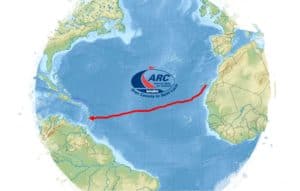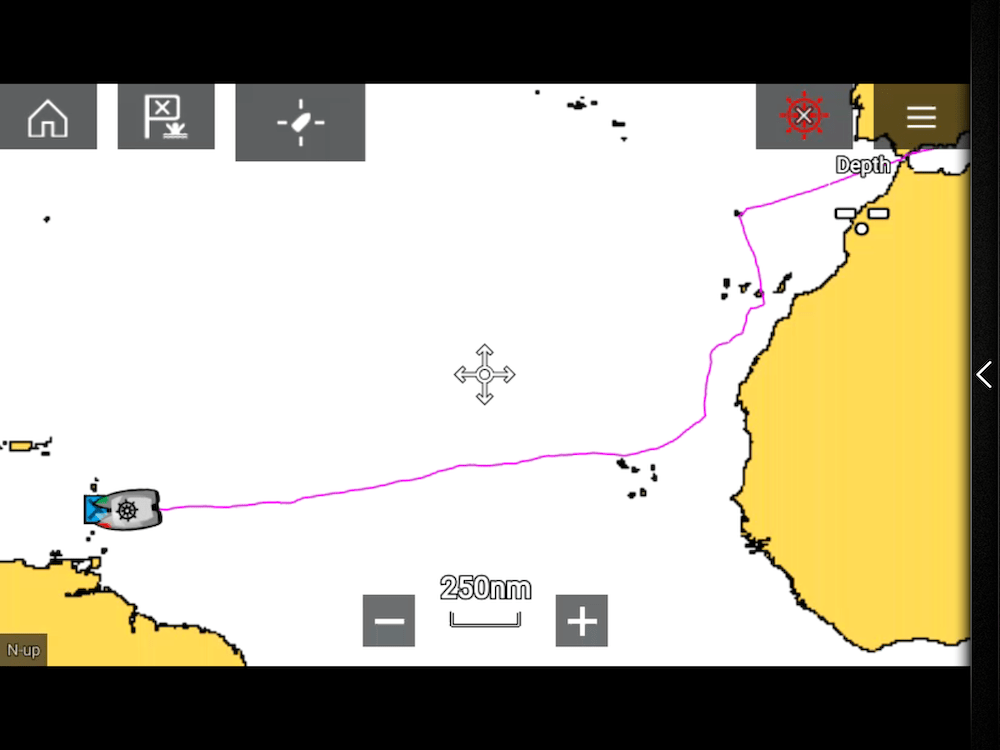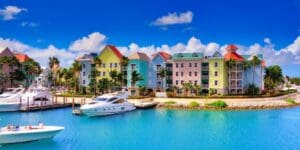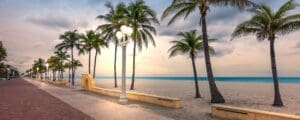 After 16 days and 17 hours at sea and sailing 3,106 Nautical miles, we arrived in St Lucia from Las Palmas in the Canary Islands onboard Zuri 3 (Z3, for short), our new Bali 5.4 catamaran. We joined the Atlantic Rally for Cruisers (ARC) on November 24, 2019, mainly for the camaraderie and a little competition along the way. We got that and more among our eight crew members and the crews of all 200 boats. This was a great experience!
After 16 days and 17 hours at sea and sailing 3,106 Nautical miles, we arrived in St Lucia from Las Palmas in the Canary Islands onboard Zuri 3 (Z3, for short), our new Bali 5.4 catamaran. We joined the Atlantic Rally for Cruisers (ARC) on November 24, 2019, mainly for the camaraderie and a little competition along the way. We got that and more among our eight crew members and the crews of all 200 boats. This was a great experience!
The ARC is a well-organized event with plenty of interesting fun and informative seminars and parties before and after the rally. We were invited by the ARC management to present a seminar for the 40 multihulls on “Downwind Sailing on a Catamaran”, hosted by Lagoon Catamarans. The seminar turned out to be more of a discussion or Q&A – a format that we prefer since, as we explained to the organizers, the book on catamarans / multihulls is still being written. Technology constantly improves and sailing techniques for cats change so fast that when you think you have it in the bag, some new technique or feature surprises even the experts.
Preparation
Like all the other crews, the preparations onboard Zuri 3 reached fever pitch on the last day before the start of the rally. Even though we were well prepared ahead of time, we checked all systems one last time. The rigging got another once-over and our charging system (Watt&Sea Hydrogenerator) was tested once again, a piece of equipment we knew we would rely on heavily. We bought our last provisions (fresh produce and bread) and did the last laundry. One of the last things we did was a safety briefing with the entire crew. We discussed all possible scenarios and made sure each crew member knew what was expected of him or her in case of an emergency. We tested the MOB personal safety devices and checked our ditchbag one more time. We booked a table at a really excellent restaurant for our last meal ashore on Saturday and had a good time discussing our “winning strategy” for the race.
Galley & Provisioning
When at sea, life revolves around the galley. Don’t forget that your body is in constant motion even when you’re asleep. As a result, you use up a tremendous amount of energy and add to that the fresh air and daily activities on deck and you work up a good appetite. Therefor the crew needs good nourishing food and a snack or two in between. I have done several long passages for which I had to provision but this time was as easy as I have ever had it on a boat.
My friends Lynda and Janine are both excellent cooks and are no slouches when it comes to whipping up a gourmet meal and the galley in this boat is enormous and the storage is plentiful. The fridge is a full size energy saving refrigerator and freezer with built-in icemaker and filtered water dispenser. What a luxury that is!
We planned for two weeks of provisions, three meals a day and added another two weeks of emergency rations. It turned out that we were spot on with our estimates and we had fresh fruits and vegetables for another week by the time we arrived in St Lucia. That fridge! LOL
The entire crew lost weight, not because of lack of food but rather because we all worked hard at keeping Zuri on track. We therefor made sure that the crew ate well every day. We had some of the most amazing meals, freshly baked breads, pizza, cakes and pastries.
Weather & Strategizing
All of us poured over the weather GRIB files that we pulled down from various sources, the week leading up to the start of the ARC Rally. The day before the start, we compared the weather GRIBS with the suggested route from the weather guru, Chris Parker. Based on his forecast and our own conclusions, we decided to go south towards the Cape Verdes before turning west towards our end destination in St Lucia. It turned out to be a good decision as most of the fleet that went more west, got caught in a huge high-pressure system with very little wind.
Start of the ARC Rally
The rally started the morning of November 24, 2019. Z3 sailed us out of the Las Palmas harbor on a bright sunny day with great fanfare as we waved the crowds adieu. We made our way to the start line along with 200 other boats. It was a sight to behold! The start was staggered with the multihulls first to leave. Almost immediately after the start gun went off, the performance catamarans flew by the committee boat, popping colorful spinnakers.
Z3 was among the first catamarans to cross the start line and the crew set about getting our spinnaker up. She immediately took off like a scalded cat and within no time we were sailing in the double digits alongside the faster cats. We soon reached a top speed of 16.5 knots! It was almost scary but so exhilarating! We were all running on adrenaline and were on hyper alert. None of us were really prepared for the energy that the Bali 5.4 showed and it took a little time to find our rhythm.
By the second day the crew was settled in and adapted their sleep patterns to the watch schedule with a rotation of 2 crew members, 2 hours on and 4 hours off. Everyone got plenty of rest and was alert when they needed to be. When we left Las Palmas, we were surrounded by boats but by the 8th night the fleet had thinned out and we could only see one or two boats on the horizon.
The first few days were pretty exciting with a few sail changes and lots of sail trimming and tweaking. We had some squally weather at one point and rougher sea conditions which meant that we had to pay closer attention all the time because we just did not want to get caught with this huge Asymmetrical sail in a big gust of wind.
On day six we have finally made the turn west just north of the Cape Verdes and were now heading straight for St Lucia. On day seven the winds finally picked up around 6PM last night to around 15 knots and we did a respectable 216NM for the day. Yay!! According to the ARC report, we were 4th behind the performance boats on “Velocity Made Good” to destination. This motivates the crew no end to know that we were among the top contenders amongst the the “faster” boats like the TS5 (no 1), a TS42 (no 2), the Nigel Irens 80 (no 3), Zuri (no 4), Outremer 5X (no 6), Outremer 51 (no 7), Swisscat 51 (no 8). But of course this was early in the race and we will no doubt fall back over time. By this time, the tradewinds had finally kicked in at around 12 – 15 knots and Zuri loved the conditions and we were on a course directly for St Lucia.
The ARC sent out a bulletin every day with the positions of all the boats In the rally and we followed them closely to see how we compared, as did all the crews on the boats with us. It was a daily discussion among our crew about who to chase, who our biggest competition was (it changed daily), how to improve our position and how to make the boat perform better. This strategizing kept us occupied for several hours every day and gave us something to chase rather than just sailing aimlessly. It made our days really exciting.
Then disaster struck, 1600 NM from our end destination! We had just settled in for our night watches on day eight when we were all called on deck at around 9pm. The Spinnaker emergency tack line was tripped by accident. Fortunately, it was held on by the preventer and Stephen immediately blanketed the spinnaker with the mainsail and we quickly doused the spinnaker and remedied the situation. No foul and everything were back to normal within no time. The shifts changed at 10pm. At midnight we were again called up on deck. We scrambled to get our harnesses on as we heard the wild noise of slapping sails outside.
Once on deck we realized that the spinnaker had split high up on the head and this time the sail was trailing over the bow in the water, being dragged alongside the boat. The head piece was flying high, held on by the halyard. Stephen did a crash stop to settle things down. We wrestled the sail back onboard, retrieved the halyard and the remaining part of the sail and retrieved sheets and lines and we were about to hoist the Code Zero on the bowsprit when we heard the main sail collapse. The utter shock of yet another failure registered on everyone’s faces and rendered all of us immobile for a few seconds. Yup, when it rains, it pours!
The main halyard broke and it appeared that once again chafing was the culprit. We secured the mainsail, deployed the jib to hold course and quickly hoisted the Code Zero so we can sail the remainder of the night on this one sail until we could remedy the problem the next morning. By 1:30am Humpty Dumpty was put back together again and we all went back to sleep and our watch schedule continued.
This cost us at least 24 NM in distance, another two days at sea and we are down a very expensive and valuable sail! Fortunately, no one was hurt and Zuri was chugging along, albeit a bit slower. This morning at first light, we got up and assessed the damage. The spinnaker was completely shredded and rendered useless.
With no main halyard, we had to improvise. We decided to “chafe-proof” the topping lift and use it as our main halyard, which created a few challenges but at least we now had a working mainsail, although permanently rigged with one reef. Five hours later all repairs were done including some jury rigging and we fitted more chafe gear and we are back in business. The crew were exhausted and all took long naps during the day to catch up on lost sleep of the night before. The swell built to about 6-8ft and with the light winds and quartering seas, it was a rather uncomfortable ride. Stephen decided to deploy both Code Zero and jib wing-on-wing and sail dead downwind. This gave us more sail area and we immediately experienced a much smoother ride. The boat seems to like this arrangement and we were happily surfing down the waves. This had been our sail plan for the remainder of the trip. Unfortunately, the trade winds remained very light throughout our entire trip across the Atlantic and without our Asymmetrical spinnaker, which was supposed to be our power sail for light winds, we limped along, sailing wing-on-wing with our Code Zero and jib.
Memorable Atlantic Crossing Highlights
We had quite a few highlights like when we hit 16.5 knots under Asymmetrical just a few miles into the start of the race and also when we logged our top speed of 18 knots surfing down 10-12ft waves. Another memorable event for the entire crew was the barbecue on the foredeck under full sail surfing down ten foot waves. What a thrill ride it was!
We celebrated a few times in the middle of the Atlantic Ocean including Thanksgiving and our (Stephen & Estelle’s) wedding anniversary on December 1st. We did the Atalantic crossing the first time on our 5th anniversary on our 45ft monohull, Royal Salute, from Cape Verdes to Antigua in 17 days. We did a similar distance (Cape Verde to St Lucia) in 9 days on our catamaran this time around. That is less than half the time! How times have changed!
For our six crew members sailing the ARC Rally was a “bucket list” item ticked off. For us (Stephen and Estelle), it was a feeling of excitement, gratitude and finally relief. Everyone arrived safely and we now knew that we chose a great sailboat! We had every confidence in our vessel and that goes a long way towards making such a long trip enjoyable. While we had rigging problems, it was nothing that we could not fix. As in most things, if well prepared, one can overcome most adversities. We had all the tools and spare parts available to make minor repairs, and we spent a couple of weeks in the Mediterranean after we picked Z3 up in France to work out the kinks for added confidence that we could handle problems that always come with sailing.
Our crew was fantastic in every respect. Each of us knew what was expected and we got on with the job, while on friendly terms. It helps of course that the Bali has a huge flybridge, salon and foredeck. Each crew member had a place to chill, relax and recharge without being on top of each other.
Victories and Challenges
The trip was exhausting at times, but we also celebrated some victories! We caught a few mahi-mahi when our boat speed slowed to around 6 knots when the winds dropped on us. It gave the fish time to catch up to our lures finally! Apparently, the fish just do not swim fast enough to catch us at 9 or 10 knots (LOL).
Each morning, we found we had picked up several flying fish on the deck. Donald decided to scale and serve one to Florian for breakfast one morning. The French apparently likes fresh raw fish for breakfast as Florian was delighted with this little fresh gift from the sea!
We sailed south for about six days mostly under our asymmetrical sail to catch the trade winds. Once we turned west at Cape Verdes we mostly sailed downwind with the jib and Code Zero in a wing-on-wing configuration after we blew the spinnaker about 1600NM from the finish line. Almost right after we managed to wrestle the spinnaker back onboard, the main halyard had chafed right through (in an unexpected and unprotected spot) and the mainsail came crashing down. With no main halyard, we had to improvise. We decided to “chafe-proof” the topping lift and use it as our main halyard, which created a few challenges. But at least we now had a working mainsail, although permanently rigged with one reef.
The loss of our spinnaker was a real bummer and slowed our progress significantly. It was no doubt our lowest point of the trip and we used the torn bagged-up spinnaker as a VERY expensive “sofa cushion” on the foredeck for the rest of the trip. At the time we blew the spinnaker, we were sailing neck-on-neck with the “performance” cats like Outremer 5X and Swisscat 55 when this calamity struck. It was a little frustrating to say the least.
Finishing the Race in St Lucia
We arrived on in St Lucia at 5am on the morning of December 6th in the dark. We informed the committee boat from about two miles out, that we were due in and a friendly voice with a British accent greeted us and guided us through the finish line in the pitch darkness just before daybreak. A photographer greeted us on a dinghy to film our “triumphant” finish as we ghosted across the line in but a breath of wind. We were met at the dock by two ARC Rally crewmembers with check-in procedures, some local information, and celebratory rum punches.
We never stopped celebrating all day so you can imagine how that day ended for the crew!
Bali 5.4 Performance in the ARC Rally
Our official arrival date and time was 11/12/2019 09:01:54 – 16 Days, 17 Hours (elapsed time). Corrected time was 19 Days 10:58:03 after a penalty for motoring of 23 hours x 1.8. Ouch!! Cruising boats are allowed to motor and, of course, reporting your motor hours is done on the honor system. We decided to take the penalty rather than wallow at sea for hours without any breeze.
Most of the performance boats (about 8 cats in all) including ourselves took the same southern route towards Cape Verde Islands before turning west in search of wind and sailed 3100NM, instead of the 2,700NM of the boats sailing a more direct westerly course. We were the first production boat over the line that followed that route.
We placed 5th in our class behind some race boats like the Marsaudon TS 5 and TS 42. The Lagoon 52s that finished ahead of us elected to take the shorter route along with the majority of the fleet. People were really surprised that we beat the performance boats like Outremer 5X and Swisscat 55 over the line in St Lucia.
Considering the challenges we faced with our spinnaker breaking and multiple chafing issues etc. we are thrilled with the result and we surprised many people with the sailing ability of this catamaran. Our Bali 5.4 was no doubt the star of the show for us. All the participants including our dock mates in Las Palmas on a 50ft monohull racer called Rumbucket was beyond surprised at the performance of our “mansionmaran” as she was nicknamed.
By all accounts we had a great crossing. We tested our boat in various weather conditions and sail configurations with speeds of up to 18 knots, surfing down waves. The Bali 5.4 is solid, the underwater design is fast, and she is comfortable in most conditions, even if a little skittish, being so buoyant. She has slippery hulls and is specifically designed to handle the weight of a well-equipped cruising cat.
While we wanted to do well in the rally, we also wanted to be comfortable and have a good time while doing the long sail crossing the Atlantic with eight people. The Bali certainly lived up to the hype and we all agreed that the solid foredeck of the Bali makes it not only super easy to work the sails upfront, but we discovered a perfect area to have a barbeque while underway downwind.
ARC Rally Boat Positions and Ratings
For background on where we are in the ratings for the ARC Rally:
- There were 40 multihulls out of about 200 entrants.
- There were two multihull classes; A and B. We were in the A class along with all the performance catamarans like the super-fast Nigel Irens 86, the Marsaudon TS50, TS 42, the Outremer 5X, Swisscat 55, Grainger 60 and Catana 50.
 Our rating was not fantastic compared to the other cruising cats but acceptable. We decided that instead of protesting our rating, we simply would have to outperform our rating and that we did! The catamaran brands in the rally were
Our rating was not fantastic compared to the other cruising cats but acceptable. We decided that instead of protesting our rating, we simply would have to outperform our rating and that we did! The catamaran brands in the rally were
- 17 x Lagoons
- 2 x Balis
- 2 x Catanas
- 5 x Fountaine Pajot
- 2 x Leopards
- 3 x Nautitechs
- 2 x Outremers
- 1 x Sunreef
- 1 Nigel Irens 86 (the rocket ship of the multihulls)
- 1 x Grainger
- 3 x Marsauden TS’s.
ARC Rally Fun Facts
By the time we arrived back in Florida with Z3 on January 11, 2019:
- We lived aboard and traveled full time onboard Z3 for 3 months after picking her up in Canet, France on October 20, 2019.
- We traveled roughly 6112 NM, an average of 2000nm per month.
- Our average speed was 7.765 knots across the Atlantic.
- Top recorded speed was 18 knots.
- We sailed to 14 different countries, islands and protectorates: France, Spain, Gibraltar, Morocco, Portugal, Canary Islands, St. Lucia, Martinique, Guadeloupe, St. Nevis, Sint Maarten, British Virgin Islands, Bahamas, and our final destination being Florida, USA.
- We went through 7 different time zones since we left France, four of them while crossing the Atlantic.
Most of the performance boats (about 8 cats in all) including ourselves took the same southern route towards Cape Verde Islands before turning west in search of wind and sailed 3100NM, instead of the 2,700NM of the boats sailing a more direct westerly course. We were the first production boat over the line that followed that route.
We placed 5th in our class behind some race boats like the Marsaudon TS 5 and TS 42. The Lagoon 52s that finished ahead of us elected to take the shorter route along with the majority of the fleet. People were really surprised that we beat the performance boats like Outremer 5X and Swisscat 55 over the line in St Lucia.
Considering the challenges we faced with our spinnaker breaking and multiple chafing issues etc. we are thrilled with the result and we surprised many people with the sailing ability of this catamaran. Our Bali 5.4 was no doubt the star of the show for us. All the participants including our dock mates in Las Palmas on a 50ft monohull racer called Rumbucket was beyond surprised at the performance of our “mansionmaran” as she was nicknamed.
By all accounts we had a great crossing. We tested our boat in various weather conditions and sail configurations with speeds of up to 18 knots, surfing down waves. The Bali 5.4 is solid, the underwater design is fast, and she is comfortable in most conditions, even if a little skittish, being so buoyant. She has slippery hulls and is specifically designed to handle the weight of a well-equipped cruising cat.
While we wanted to do well in the rally, we also wanted to be comfortable and have a good time while doing the long sail crossing the Atlantic with eight people. The Bali certainly lived up to the hype and we all agreed that the solid foredeck of the Bali makes it not only super easy to work the sails upfront, but we discovered a perfect area to have a barbeque while underway downwind.
Lorem ipsum dolor sit amet, consectetur adipiscing elit. Ut elit tellus, luctus nec ullamcorper mattis, pulvinar dapibus leo.





